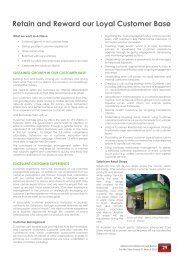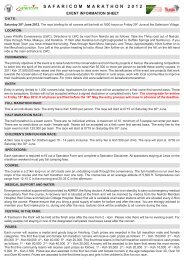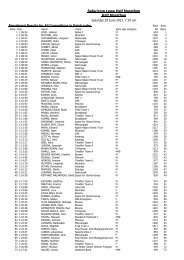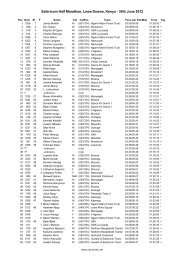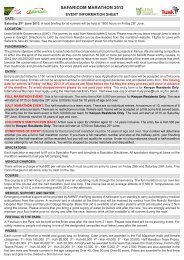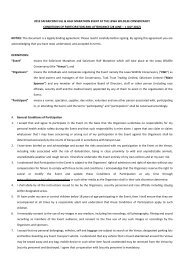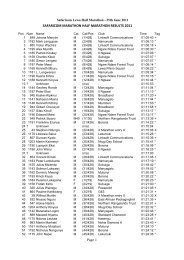Sustainability Performance: At a glance (31 March 2012) - Safaricom
Sustainability Performance: At a glance (31 March 2012) - Safaricom
Sustainability Performance: At a glance (31 March 2012) - Safaricom
You also want an ePaper? Increase the reach of your titles
YUMPU automatically turns print PDFs into web optimized ePapers that Google loves.
Network stability<br />
capacity expansion, acquiring extra bandwidth,<br />
introducing new technologies and modernising<br />
the network — upgrading radio elements,<br />
core network elements and transforming<br />
the transmission network. This network<br />
modernisation initiative has seen over 95% of<br />
Mobile Switching Centers (MSC) replaced with<br />
modern, high capacity MSCs to date.<br />
• Customer churn<br />
Customer ‘churn’ is when an existing customer<br />
leaves to join another network. The highly<br />
competitive nature of the telecommunications<br />
industry has resulted in significant reductions<br />
in tariffs and, as a result, significant increases<br />
in network traffic. This increase in traffic has<br />
led to network congestion and dropped calls<br />
etc. This congestion, together with network<br />
disruptions due to fiber cuts and power<br />
failures, has hampered service quality and<br />
resulted in customer churn. From a network<br />
stability perspective, the measures taken to<br />
reduce this sub-risk are, essentially, the same<br />
as those taken to mitigate the ‘maintenance’<br />
and ‘coverage’ risks.<br />
• Sub-optimal fiber-optic infrastructure<br />
<strong>Safaricom</strong> leases fiber-optic infrastructure to<br />
provide the additional capacity required by<br />
the large volumes of data and voice traffic we<br />
handle, but the local fiber network has been<br />
significantly impaired by fiber cuts recently.<br />
Stakeholders with whom we engage<br />
Stakeholder group<br />
Subscribers<br />
Regulator (CCK)<br />
Government (through Ministry of<br />
Information & Communication)<br />
Fiber Providers<br />
Telecommunication Service<br />
Providers<br />
What we engage them on:<br />
While mechanisms are being put in place to<br />
ensure that fiber redundancies protect traffic<br />
loss — including deploying our own fiber<br />
infrastructure — network disruptions caused<br />
by multiple fiber failures remain a major<br />
challenge. In <strong>March</strong> <strong>2012</strong>, for instance, up<br />
to 20% of network unavailability was due to<br />
fiber failures.<br />
As well as spreading the risk across multiple<br />
fiber providers and specifying continuity<br />
in service level agreements, <strong>Safaricom</strong> is<br />
currently implementing a BCP (Business<br />
Continuity Plan) that will see microwave<br />
backups installed at all major nodes,<br />
providing alternative traffic routes in the<br />
event of a fiber failure. These are already in<br />
place at Tier 1, high-risk locations and Tiers<br />
2 and 3 will be completed in August <strong>2012</strong>.<br />
• Vandalism and theft<br />
As already noted, the repeated vandalism<br />
of telecommunications infrastructure often<br />
leads to network instability disruptions. As<br />
a result of engagements with regulators<br />
and stakeholders by <strong>Safaricom</strong> and other<br />
operators (see Section R1. for further<br />
detail), the Vandalism Bill has been drafted<br />
and is ready to be enacted into law by<br />
Parliament.<br />
Information regarding planned works and network failures is<br />
promptly disseminated to Customer Care for communication to<br />
subscribers.<br />
Engagement with the CCK has taken place regarding the drafting of<br />
the Vandalism Bill and the CCK’s targets (KPIs).<br />
Again, we have liaised with government regarding fees, levies and<br />
the drafting of the Vandalism Bill.<br />
<strong>Safaricom</strong> leases fibre from fibre-optic providers and engages with<br />
them regarding SLAs and BCPs etc.<br />
<strong>Safaricom</strong> has agreements with other mobile operators to share<br />
some of its BTSs, and vice versa.<br />
How we performed<br />
The Communications Commission of Kenya<br />
(CCK) is mandated with ensuring the provision<br />
of quality services by licensed mobile service<br />
operators. To meet this objective, the CCK has<br />
developed eight Key <strong>Performance</strong> Indicators<br />
(KPIs) to assess the performance of mobile<br />
operators. Mobile operators are expected to<br />
meet at least 80% (i.e. 7 out of 8) of the targets<br />
set by these KPIs.<br />
The CCK carries out national Quality of Service<br />
(QoS) assessments based on these KPIs, to<br />
determine the level of compliance achieved<br />
by mobile operators. The results of these<br />
assessments are released to the general public<br />
and can also be found on the CCK website.<br />
Subscribers<br />
Speech Quality (MOS, PESQ values) 95% of Samples >2.7<br />
Regulator Handover (CCK) Success Rate 85%<br />
Call Set Up Time



